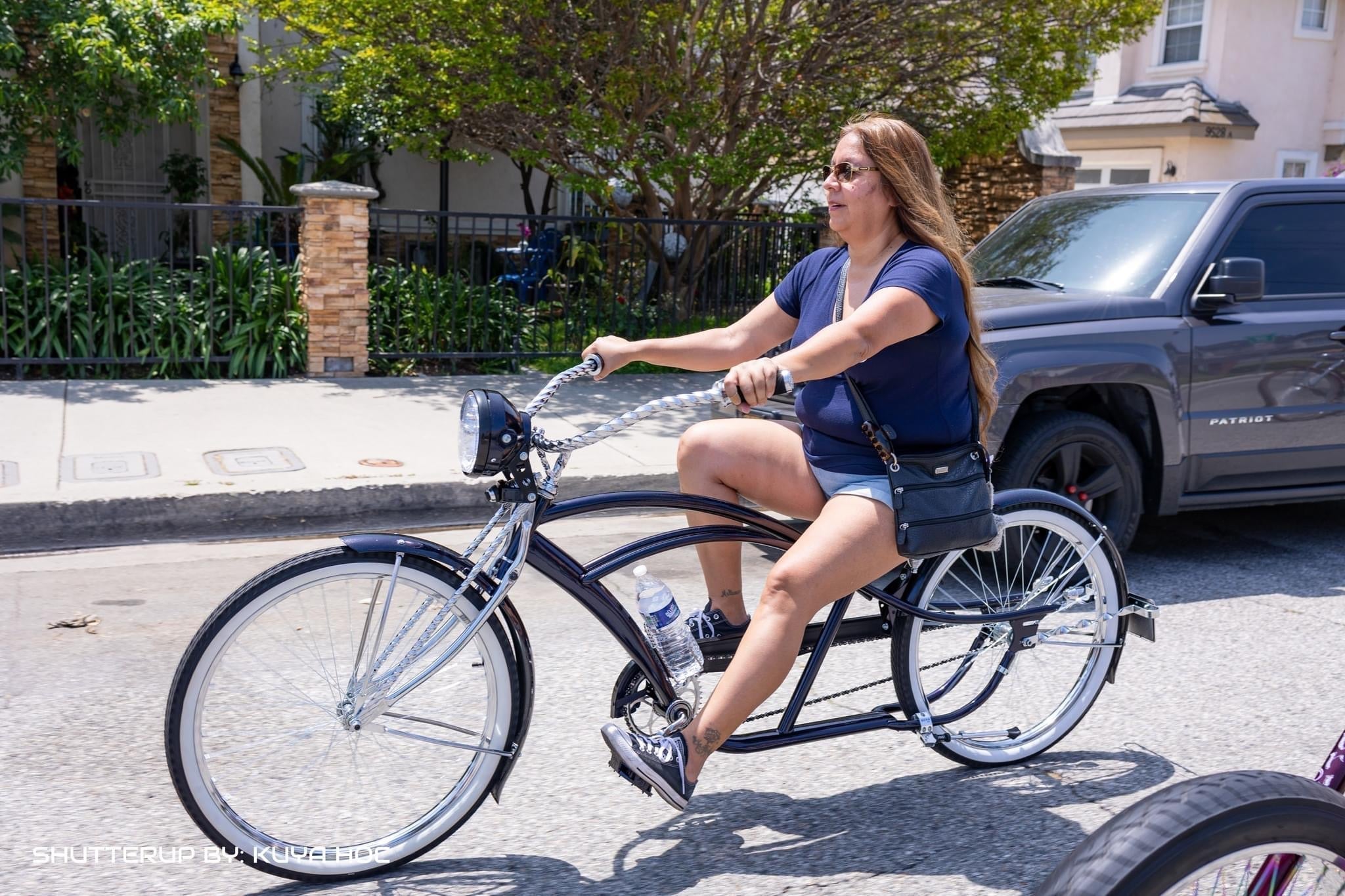Have you ever been troubled by the labels of "men's" and "women's" when you walk into a bike shop and face a dazzling array of cruising bikes? What design differences are hidden behind these 'men's' and' women's' labels? Does it really determine who should ride which cruiser bike? Today, let's uncover the truth behind the gender labels of cruising bikes and explore the true selection criteria.
Gender-Based Design Differences in Cruiser Bikes
The gender differentiation of cruise bikes in the market is usually reflected in several obvious aspects.
- Type of frames: The traditional "women's" cruise bikes generally use a step-through frame, whose crossbeam is low and curved; The 'men's' models are often equipped with diamond frames, which have higher upper pipes and a more robust overall structure.
- Size range: 'women's' cruiser bike is mainly in small sizes, suitable for more people with shorter heights; the' men's' cruiser bike focuses on medium to large sizes, covering the needs of tall people.
- Seat design: with "women's" seats often being wider and softer, providing riders with a more comfortable experience; The "men's" bike seat is relatively narrower.
- Color and decoration: the "women's style" tends to have soft tones and often has floral patterns as decoration; The colors of the "men's style" tend to be more stable and darker, with simpler decorations.
Design differences: based on requirements, not gender
By delving deeper into the origins of these design differences, we will find that they are more based on actual needs rather than being determined by gender.
- Type of frames: The inclined beam frame was originally designed for people wearing long skirts to get on and off the vehicle, and was very practical for women in the early 20th century. However, now its convenience benefits men wearing long pants and those with limited joint mobility - this is precisely the embodiment of the demand-oriented design of cruiser bikes.
- Size range: Small sized cruiser bikes are not only suitable for women, but also for shorter bodied riders - bike size selection is not related to gender, only to body shape. Similarly, large-sized bikes are also designed for tall people, regardless of gender.
- Seat design: the wide and soft seat may be positioned as a "women's model" in the market, but in reality, anyone who pursues a comfortable riding experience will be attracted to this type of seat, and men are no exception.
So, these design differences are not "gender specific" but are designed based on the actual needs of different groups of people, and are a manifestation of demand-oriented design.
Real comparison: Tracer Osaka 700C series analysis
The best way to analyze gender differences in cruise bikes is through specific examples. The Tracer Osaka 700C series, as a representative product in the market, provides us with an excellent comparative case between its "men's" and "women's" versions, allowing us to clearly see where the so-called gender differences are reflected.
Frame size and geometric structure
The Tracer Osaka 700C men's model offers two frame sizes of 530mm (21 ") and 580mm (23"), while the women's model offers smaller frame sizes of 390mm (15 ") and 480mm (19"). This reflects the traditional belief that men are generally taller than women, but these size differences are actually based on body shape, not gender. A man who’s 5’7" might find the women’s 480mm frame more comfortable, while a woman who’s 5’9" could be better suited to the men’s 530mm frame.
Appearance Design and Color Selection
In terms of color, the men's Tracer Osaka 700C comes in neutral colors like Midnight Blue, Matte Black, Green, and Grey, while the women's version offers more diverse options such as Aquamarine, Black, Olive Green, Red, and Vanilla. This color distinction follows traditional gender stereotypes, but color preferences are actually personal and shouldn't be limited by gender labels.
Weight and portability
The women's Tracer Osaka 700C weighs 30 pounds, slightly lighter than the men's 32-pound version. This difference comes from material variations due to frame size differences, not gender-specific design. While weight is important for those who frequently move their bikes or prefer a lighter ride, this consideration isn't gender-dependent.


Consistency of core functions
When we delve into the core functions of the two bikes, we will find that they are almost identical. Both Tracer Osaka 700C cruiser bikes are equipped with Shimano NEXUS3R40 3-speed internal transmission system, reliable V-brakes, 700C alloy wheels, and black tires, as well as practical crescent handlebars and integrated rear shelves.
The comparative analysis of Tracer's Osaka 700C series reveals that "gender-specific" bike differences primarily concern size and appearance, rather than essential functions. These differences are based on body size statistics and traditional marketing, not actual physiological needs. When choosing a cruise bike, consumers should focus on frame size fit, color preferences, and functional requirements rather than being limited by "men's" or "women's" labels.
Do you want to know more about cruiser bike models? Click to view the full selection guide for the entire series
Core Standards for Choosing Cruiser Bikes
1.Suitable for individual body shape:
- Height matching: When choosing a bike frame, there should be a 1-2 inch gap between your crotch and a low span frame, or 1-3 inches clearance from the top tube of a diamond frame. This prevents collisions when getting on and off. Generally, riders 5'3"-5'7" tall fit medium frames, those over 5'7" need large frames, and those under 5'3" are better with small frames.
- Leg length adaptation: After sitting in the bike seat, when the sole of the footsteps on the lowest point of the foot, the knee should be slightly bent (about 170 °), neither locked out nor excessively bent, ensuring natural pedaling force and avoiding knee injury.
Further reading: Get the Perfect Bike Fit: How to Find the Right Size for You
2.Tailored to cycling needs:
Different usage scenarios have different requirements for the functionality of cruiser bikes, which need to be judged based on their core purpose:
- Daily commuting: Priority should be given to using a low-suspension frame (step-through frame), which facilitates quick getting on and off when putting on and taking off clothes or carrying backpacks; Additional accessories such as mudguards and baskets can be installed to enhance practicality.
- Weekend Leisure/Beach Roaming: Emphasize the relaxation of cycling, choose a wide seat, high handle design, and comfortable cushion material; If you often ride on beaches or soft roads, you can consider wide tire models to enhance grip.
- Long-distance cycling: Attention should be paid to the stability of the frame (such as the rigid support of the diamond frame), the breathability of the seat, and whether there are reserved installation positions for the water bottle rack and luggage rack to meet the range requirements.
3.Focus on riding comfort: details determine experience
Comfort is the core of long-term cycling, and the following details should be emphasized during the test ride:
- Seat: The wider the seat, the more comfortable it is. It should be selected according to the duration of the ride - for short-distance leisure, a wide and soft seat can be chosen to distribute pressure; long-distance travel requires consideration of support to avoid hip fatigue caused by excessive softness. Pay attention to whether there is any local compression feeling during the test ride, especially in the ischium area.
- Handlebars and riding posture: The height of the handlebars should allow the arms to naturally bend, the shoulders to relax, and avoid shrugging or bending over; The grip material should be anti-slip and sweat absorbing, and it should not cause soreness when held for a long time.
- Vehicle tuning: The force feedback of the pedals, the sensitivity of the brakes (cruisers are mostly designed with reverse brakes to adapt to their braking feel), and the shock absorption effect of the chassis (whether it shakes the hands too much when the road is bumpy) all need to be personally experienced during the test ride.
4.Additional considerations: Appearance and durability
- Appearance preference: The color and decorative style should conform to personal aesthetics, as the desired appearance can enhance riding power without being constrained by "gendered" design (such as men choosing light colors, while women can also handle tough styles).
- Material and workmanship: The frame material (lightweight and rust-resistant aluminum alloy, solid but heavy steel), weld treatment, and accessory quality (such as chains and wheels) affect durability. It is recommended to choose reputable brands to ensure long-term use without easy failure.
In short, the core logic of choosing a cruiser bike is "people-oriented" - whether the label is "men's" or "women's", as long as the size matches the body shape, the functions meet the needs, and the riding is comfortable enough, it is the most suitable choice. Trial riding is the key to verifying all of this; don't miss out on the truly suitable bike model due to gender labels.
summarize
Cruise bike gender differences are mainly about marketing, not actual physical needs. Step-through frames, wide seats, or specific colors shouldn't limit your choices. What matters is finding a bike that fits your body, meets your riding needs, and feels comfortable. At Tracer, we believe everyone should choose based on their needs, not gender labels. Our cruise bikes focus on comfort, practicality, and personalization, helping every rider find their perfect cycling companion without gender boundaries.



Share:
Stretch Cruisers as a Statement Bike: Ride for Style, Not Speed
Can a Cruiser Electric Bike Ride Fast? The Ultimate Guide to Cruiser Electric Bikes